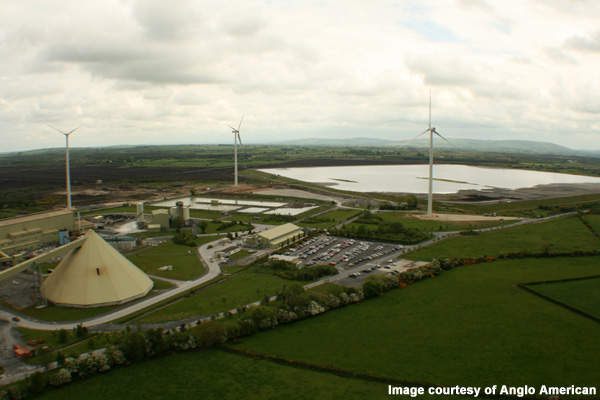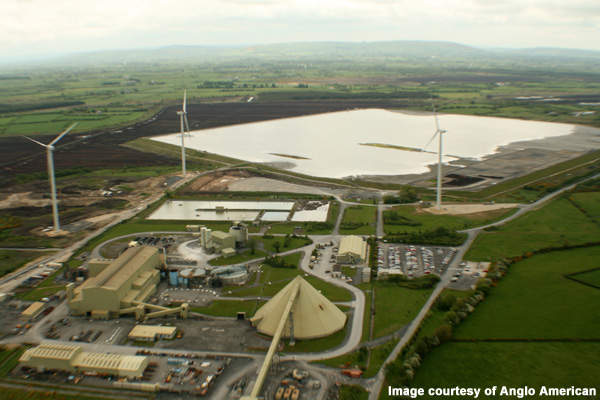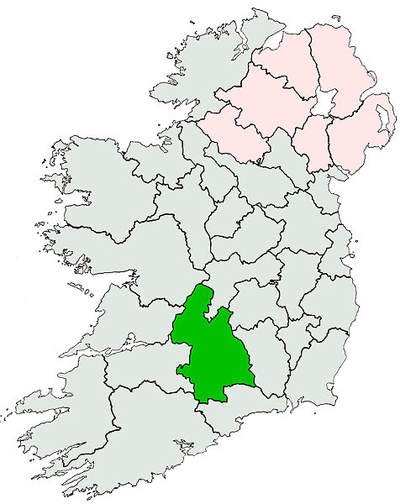The Lisheen mine is a high-grade zinc and lead resource located in the Republic of Ireland between the Moyne and Templetuothy villages in County Tipperary. Discovered in 1990, the mine is the largest producer of zinc concentrate in Europe. It began production in October 1999.
The mine was operated by Anglo Base Metals, a wholly owned subsidiary of Anglo American. It was acquired by UK-based Vedanta Resources in February 2011 for a cash consideration of $546m. As part of the deal signed in 2010, Anglo American also sold its Skorpion mine in Namibia and the Black Mountain mining in South Africa for $1.3bn.
Lisheen geology
The mine is a carbonate hosted deposit found within the Rathdowney Trend. The Rathdowney Trend extends till almost 40km between the Abbeyliex town in the North east and the Thurles town in the South West. It includes sedimentary rocks, primarily limestones, which were concentrated about 320 million years ago.
The deposit hosts two main ore bodies including the main zone and the Derryville that lie at a depth of 170m. The ore bodies are either layered or flat lying and range in thickness between 1m and 14m. It includes galena, sphalerite and pyrite with zinc and lead found in the ratio of 5:1. Mineralisation nearer to the faults appears to be thicker occasionally ranging up to 30m. The deposit is characterised by multiple faults that act as conduits allowing the hydrothermal mineralising fluids to push the metals upwards from extreme depths.
Mining
Lisheen is being mined using room and pillar, and drift and fill techniques. Blast hole stopping is adopted for areas that appear to be thicker. To access the mine, a 1.5km long decline was descended. Holes are bored in the orebody using underground drilling rigs, charged with explosives and blasted. Massive load haul dump (LHD) machines are used to remove the broken ore and load them into trucks that deliver it to the crusher.
To prevent large material from entering the crushing chamber directly prior to being fed to the underground crusher, ore is initially emptied in grizzly bars. Nearly 6,300t of ore grade material is hauled from the mine to the surface via a conveyor system. In a 12,000t covered storage facility, the ore is stockpiled before it is sent for processing to the concentrator plant.
Ore processing
Processing of the ore begins with comminution. During this process, the ore size is reduced and valuable minerals containing zinc and lead are separated from the non-valuable host rock. Through vibrating feeders, ore is conveyed from the covered stockpile at the surface to a conveyor.
The conveyor delivers the ore to a semi-autogenous grinding (SAG) mill where additional process water further reduces the particle size of the ore. The oversized discharge passes through trommel screens before being recycled back to the SAG mill for additional grinding. Medium-sized pebbles are sent to a rotary pebble crusher via a conveyor before being conveyed back to the SAG.
The second stage in processing involves floatation. To separate the zinc and lead minerals from the host rock, the slurry is agitated, reagents are added and air is pumped in to create bubbles that have minerals attached. The mineralised bubbles rise above to form a froth. The froth flows into launders and is pumped to the next processing stage. An acid leach quality control process is carried out to reduce the level of magnesium in the concentrate if required.
In the final stage, the concentrate is de-watered to make it suitable for storage and shipping. The concentrate is thickened and delivered to an un-agitated tank. To facilitate the settling process, chemicals are added that help in the formation of larger clumps of individual particles. These clumps are made to settle at the bottom before it is raked slowly to the main underflow pumping point.
The thickener underflow is sent to the respective filtration phase to carry out the final de-watering. The moisture content of the thickened concentrate is reduced to 6% for lead and 8% for zinc concentrate using horizontal pressure filters. The final filtered concentrate is then transported for shipping.






